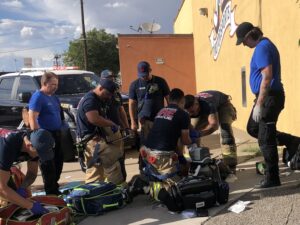7:51
News Story
Grassroots groups across the country help Medicaid recipients regain lost coverage
In 21 states that reported coverage losses by age brackets, Missouri ranks fourth in the proportion of children being removed from Medicaid
Eight months after states started dropping millions of low-income families from Medicaid rolls, grassroots groups say they are leading the push to re-enroll people denied coverage for bureaucratic reasons.
Nationwide, more than 12.5 million people have lost coverage since April. That’s when the federal pandemic provision that had required states not to drop anyone from the rolls expired and states restarted income eligibility checks.
Federal officials over the summer allowed states to exercise flexibility to avoid potentially unnecessary coverage losses, and mailed letters to governors warning that high numbers of removals for procedural reasons and long wait times could violate federal rules.
Still, as of Dec. 13, 71% of the people who were dropped lost their coverage through “procedural” disenrollments — that is, they were missing paperwork or otherwise didn’t complete the renewal process by a specified date — according to health policy research organization KFF.
Many of those people may be eligible for coverage, but struggle to get the paperwork through state bureaucracies.
Children, young adults, and Black and Hispanic people are overrepresented on the Medicaid rolls, compared with their share of the overall population. A federal Office of Health Policy brief published in August 2022 ahead of the unwinding estimated that nearly one-third of those predicted to lose coverage would be Hispanic and another 15% Black — groups with health disparities that were magnified during the pandemic. About 60% of Medicaid enrollees are Black, Hispanic, Asian or multiracial.
More than 2.4 million children have lost coverage. On Monday, the U.S. Department of Health and Human Services issued another warning, mailing letters to governors of nine states — Arkansas, Florida, Georgia, Idaho, Montana, New Hampshire, Ohio, South Dakota and Texas — with the highest rates of children dropped from the rolls.
Officials urged those states, which together have dropped 60% of the children who have lost Medicaid coverage nationwide, to use flexibility provided by federal officials to “help prevent children and their families from losing coverage due to red tape,” noting the efforts are “especially important for children and families of color.”
The department also noted that the 10 states that have not expanded Medicaid — Alabama, Florida, Georgia, Kansas, Mississippi, South Carolina, Tennessee, Texas, Wisconsin and Wyoming — “have disenrolled more children than those that have expanded combined.”
Federal officials also announced that relaxed rules that allowed automatic renewals will be continued through the end of 2024 to give states more time and keep more families covered.
States have released online tools to help local leaders and providers offer guidance on how to enroll. Texas, for example, created “ambassador” toolkits in Spanish and English, with social media graphics and flyers geared toward families and older residents on how to set up an online account to re-enroll. Utah said it developed billboard and radio ads along with its own toolkits and flyers in 13 languages.
Still, grassroots groups say they are doing the heavy lifting.
These advocates’ outreach efforts go “beyond the walls of the capitol,” said Dr. Dena Hubbard, a neonatologist at Children’s Mercy hospital in Kansas City who chairs the public policy committee of the American Academy of Pediatrics’ Kansas chapter.
“[They’re] going to people, meeting people where they are in their communities, knowing what they need, knowing where they are, and helping them get the services they need,” she said. “I strongly feel that grassroots is where it’s at.”
‘Frustrated and nervous’
Karina Gonzalez’s 18-year-old son only has enough psychiatric medication to get him through the end of December.
The Kansas City, Kansas, mother of four is worried about what will happen next. Her family was dropped from Medicaid coverage in October, and the kids haven’t been able to go to any doctor’s appointments, she said.
Gonzalez’s household relies on the income of her husband, who works in construction.
“It has affected us,” Gonzalez said in Spanish as her 16-year-old daughter translated. She said she feels “frustrated and nervous,” especially amid flu season.
Gonzalez received a letter the first week of October saying the family was no longer covered. She said she didn’t know why they were dropped and struggled with the online KanCare system, which isn’t available in Spanish. That’s when she reached out to El Centro, a community health advocacy group that assists Kansas Latino families. Spanish-speaking patient navigators there have been helping her collect and submit documentation to get re-enrolled, she said.
Matt Lara, chief of staff of the Kansas Department of Health and Environment, said aside from the online portal, applicants and families renewing whose first language isn’t English can call and be connected with a language assistance line.
“Kansas is not a Medicaid Expansion state which means that our eligibility threshold for non-disabled, non-pregnant adults is incredibly low,” Lara said in an emailed statement on the rate of children losing coverage. “As a result, over 2/3 of our enrollees are children, and that results in them being the largest cohort of members losing eligibility.”
In Utah, Oreta Tupola is the program coordinator for the Utah Community Health Workers Association. Her community health workers have been helping families in the Latino and Pacific Islander community reapply.
Families have been calling her from the emergency room after taking a relative there and finding out they no longer have coverage. Many clients of her community health workers suffer from diabetes, high blood pressure and heart disease, and take essential medications for the conditions.
“We started getting calls now from our clients saying, ‘I went to the doctor, or I’m at the ER, and I can’t get in. They won’t see me,’” Tupola said. “[They’d say] ‘I didn’t know I didn’t have coverage.’ Or one of the women that called me said, ‘Hey, I’m trying to go pick up my medicine and when I went to get my medication, that’s when I found out that I don’t have Medicaid anymore.’ Now we’re scrambling to get them back on and approved, which is another long process.”
Many of those who lost Medicaid coverage could qualify for it. Utah has the second-highest rate of people who lost coverage for administrative or paperwork reasons at 94%, following New Mexico at 95%.
New Mexico’s Health Services Department told Stateline in an email that it is using multilingual awareness campaigns along with some of the relaxed federal rules, such as a 30-day delay in procedural terminations, which extends the renewal deadline. As a result, the department asserts it is “seeing minimal eligibility closures.”
Assessing the changes
Last week, in two columns published in the monthly peer-reviewed health care journal Health Affairs, health policy experts addressed the unwinding.
“It should no longer be acceptable to maintain policies and practices that make it so difficult for people to enroll and retain their coverage,” wrote experts from the Center on Budget and Policy Priorities, a research and policy institute that advocates for left-leaning policies. They said the process has cast a light on the nation’s “fragmented” health care system.
Allison Orris, a co-author and senior fellow at the center, said in an interview the continuous enrollment period showed the benefits of minimizing red tape on a larger scale.
The churn “is magnifying some of the challenges that have always existed in systems,” she said. “The pandemic really laid bare a lot of fractures across many social services programs, and in Medicaid, we know that there have always been a high number of people who were eligible for Medicaid but not enrolled — and that is likely a sign that it was too hard to get enrolled and to stay enrolled in coverage.”
Craig Wilson, director of health policy at the Arkansas Center for Health Improvement, co-authored the second column. Georgetown University’s Center for Children and Families reports Arkansas has the largest share of rural children covered by Medicaid. About 59% of Medicaid enrollees lost coverage in Arkansas.
Wilson is calling for a multistate assessment to compare states’ eligibility redeterminations, who was most affected geographically and demographically, and where and whether they found other coverage — or fell through coverage gaps.
“There are some opportunities to learn from what happened here that can be applied in future situations,” especially for at-risk communities, he told Stateline. “If there are states that did some things differently, and were more precise, in identifying people who were either eligible or ineligible, and having them go in the appropriate direction.”
In Arkansas, 77% of the people dropped from Medicaid lost their coverage for procedural reasons, while 23% were dropped because they were deemed ineligible, according to KFF. Children account for more than a third of those who lost coverage in Arkansas.
Meanwhile, about 71% of Arkansans whose coverage was renewed retained coverage via the federal rule that allows states to use previous income records.
Children without coverage
Across 21 states reporting coverage losses by age brackets, 2.4 million, or 40%, of the people dropped from the rolls were children, according to KFF’s analysis.
After Texas at 61%, Gonzalez’s Kansas ranks second among those 21 states in the proportion of children losing coverage, (55%), followed by Idaho (48%), Missouri (47%), Alaska (43%) and Minnesota (42%).
Of the 21 states, Massachusetts had the lowest proportion of children disenrolled at 18%, followed by California at 21%. Some states, such as North Carolina and Kentucky, are keeping kids with pending renewals covered for another year while the states work on eligibility redeterminations.
But experts such as Wilson worry that lack of communication from state Medicaid offices for another year will cause further confusion around coverage.
“Many of those folks may not have had any communication with the Medicaid office in three or more years,” he said. “With a rather transient population, it’s going to become much more of an issue when the span of eligibility rate determination is much longer.”
For now, some grassroots groups are relying on general outreach such as putting up flyers and setting up tables at community events.
Tupola, of the Utah Community Health Workers Association, said she wishes state Medicaid offices supported those on the ground like her organization, especially after national attention on the benefits of grassroots vaccination campaigns throughout the pandemic.
“I think we don’t ever get called to the table until … the numbers are high, people are dying, or people are losing coverage,” she said.
“You need to bring us in from the very beginning.”
Stateline is part of States Newsroom, a nonprofit news network supported by grants and a coalition of donors as a 501c(3) public charity. Stateline maintains editorial independence. Contact Editor Scott S. Greenberger for questions: [email protected]. Follow Stateline on Facebook and Twitter.
Our stories may be republished online or in print under Creative Commons license CC BY-NC-ND 4.0. We ask that you edit only for style or to shorten, provide proper attribution and link to our website. AP and Getty images may not be republished. Please see our republishing guidelines for use of any other photos and graphics.





